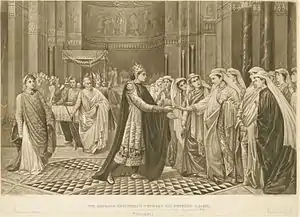Bride-show
The bride-show (Greek: δείχνουν οι νύμφες, romanized: deichnoun hoi nymphes; Russian: смотр невест, romanized: smotr nevest) was a custom of Byzantine emperors and Russian tsars to choose a wife from among the most beautiful maidens of the country.[1][2] A similar practice also existed in Imperial China.

Modern representation of Theophilos' choice
.jpg.webp)
1882 painting of Tsar Alexis of Russia choosing his bride in 1648. Painting by Grigory Sedov.
See also
References
- Bushkovitch, Paul (18 March 2021). Succession to the Throne in Early Modern Russia: The Transfer of Power 1450–1725. Cambridge University Press. p. 61. ISBN 978-1-108-47934-9.
- Martin, Russell E. (15 June 2012). A Bride for the Tsar: Bride-Shows and Marriage Politics in Early Modern Russia. Cornell University Press. pp. 23–27. ISBN 978-1-5017-5665-8.
Further reading
Wikimedia Commons has media related to The Bride-show.
- Afinogenov, D. "The Bride-show of Theophilos: Some notes on the Sources", Eranos 95. 1997, pp. 10–18.
- Rydén, Lennart. "The Bride-shows at the Byzantine Court - History or Fiction?" Eranos 83, 1985, pp. 175–191.
- Treadgold, W. T., "The Bride-shows of the Byzantine Emperors", Byzantion 49. 1979, pp. 395–413.
- Bourboulis, Photeine, “The Bride-Show Custom and the Fairy-Story of Cinderella.” In P. P. Bourboulis, Studies in the History of Modern Greek Story-Motives. Thessalonike, 1953. Pp. 40–52.
This article is issued from Wikipedia. The text is licensed under Creative Commons - Attribution - Sharealike. Additional terms may apply for the media files.